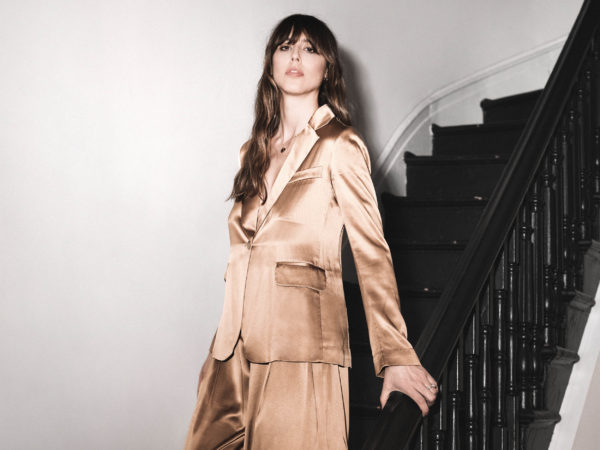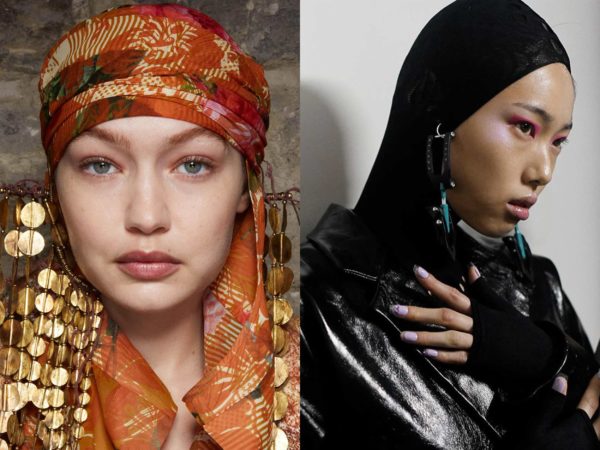From ‘Maybe She’s Born With It’ to ‘You Look Good’: how beauty brands sell us on the compulsive labor of self-optimization
The Glossier girl is carefree, charming, and preternaturally beautiful. We watch her swipe sheer gloss onto smiling lips, or dab a dot of concealer under bright eyes; she uses her hands to apply the color, finger-painting on already-flushed cheeks. Rather than showcasing the product’s effectiveness, the Glossier girl’s conspicuous lack of ‘before’ and ‘after’ underscores the importance of experience versus result. Her coy smile suggests that with the right combination of product and lifestyle, we too could attain this state of perfect imperfection.
Digital and millennial pink, Glossier entered the beauty scene in 2014 when the industry was in the midst of a body-positive rebrand. Drugstore titans like Pantene, Covergirl, and Dove had successfully leveraged women’s empowerment as a mainstream marketing strategy, tackling female-centered social issues in viral campaigns such as #ShineStrong, #GirlsCan, and ‘Real Beauty Sketches.’ The widespread success of those campaigns ushered in a new era of advertising, with brands now required to become fluent in the language of contemporary feminism while continuing to profit off mainstream beauty ideals.
Glossier was perfectly poised to fill the new demand for beauty products that integrate the feminist ideal of self-acceptance with the capitalist imperative of self-improvement. The launch of Glossier’s original product line also coincided with the popular rise of multi-step skincare, a beauty regimen which similarly blurs the experiential boundary between ritual and result. “As makeup, [Glossier] promises to mimic the effects of impeccable skincare,” wrote Haley Mlotek for The Fader in 2016. “As skincare, it promises to replace the need for makeup entirely.”
“This demographic restriction of no-makeup makeup is, of course, part of the appeal: much as Brandy Melville profits off the exclusivity of their limited sizing, Glossier provides a self-improvement ritual for women who already fit within a hair’s breadth of dominant beauty ideals.”
Glossier’s cultlike following is due in part to Emily Weiss, the company’s founder, CEO, and resident New York It-Girl, previously known for spearheading Into The Gloss, a popular blog about women’s beauty routines. With only two brick-and-mortar retail stores, the brand has leveraged their social following and philosophy of hands-on community engagement to cultivate both an avid fan-base and a high degree of visibility. Glossier’s signature pink pouch—a free gift easily repurposed as a chic makeup bag, travel case, or even a handbag—has become an omnipresent accessory among millennial women, much as the free canvas totes that come with a New Yorker subscription became an iconic status symbol on the streets of Manhattan.
The Glossier Flagship, which is located within spitting distance of my workplace, routinely draws crowds of millennial devotees waiting in line while brand representatives dole out boxed water or free umbrellas (“Isn’t their entire business model making you pay crazy amounts of money for repackaged vaseline and oxygen?” asked my colleague when I brought this up on Slack.) Indeed, Glossier has been criticized for the practical limitations of their sheer, barely-there makeup products (“Glossier Announces New Line of Makeup For Women Not Already Beautiful,” reads the title of Mara Wilson’s 2017 article for Reductress, where she describes the brand’s popularity among “models, future models and Instagram models,” introducing a new parody product line, “Prettier,” that will contain “actual tints.”) This demographic restriction of no-makeup makeup is, of course, part of the appeal: much as Brandy Melville profits off the exclusivity of their limited sizing, Glossier provides a self-improvement ritual for women who already fit within a hair’s breadth of dominant beauty ideals. The “Prettier” satire is made all the more ironic by the 2019 launch of Glossier Play, a new sub-brand of “dialed up beauty extras” that encompasses everything the original brand shied away from (though it includes sparkles, glitter, and primary colors, it still stops short of doing any cosmetic heavy lifting when it comes to concealing problem areas.)
In her 2019 essay on the compulsive labor of self-optimization, Jia Tolentino describes the ideal woman: “Everything about [this woman] has been preemptively controlled to the point that she can afford the impression of spontaneity and, more important, the sensation of it—having worked to rid her life of artificial obstacles, she often feels legitimately carefree.” Rather than compulsively applying makeup before she heads out the door, this woman has paid a premium to identify as low-maintenance. This affords her an experience of freedom from the oppressive force of beauty standards, while maintaining a level of physical appeal that has proven benefits.
“Just as the rise and fall of hemlines is informed by norms surrounding women’s modesty, the history of beauty has been marked by its fluctuating relationship with the natural.”
There is a wealth of options available to the customer looking to maintain the illusion of beauty low-maintenance: from microblading and eyelash extensions to injectables, plastic surgery, and veneers. By offering rotating discounts for services such as teeth whitening, facials, and long-lasting gel manicures, the advent of the mobile couponing app Groupon has broadened the pool of people with access to luxury cosmetic treatments previously reserved for the wealthy.
With today’s abundance of online beauty resources, makeup tutorials, and access to Facetune, everyday opportunities for self enhancement now extend beyond upper class demographics. Yet as the pursuit of beauty is becoming more egalitarian on an individual basis, the authority of the ‘natural’ and the policing of fakery remain a dominant principle in maintaining the social order. Just as the rise and fall of hemlines is informed by norms surrounding women’s modesty, the history of beauty has been marked by its fluctuating relationship with the natural (one might consider the trajectory of women’s eyebrows from the needle-thin pluck of the 1920s to the fashionably bushy eyebrows of today.)
Beauty isn’t the only economic signifier subject to revision. In the 1900s, the advent and popular adoption of plastics like celluloid and synthetic resin challenged the implicit value of material by creating identical replicas of luxury items such as ivory and amber. Suddenly, plastic imitations of powerful class signifiers could be cheaply reproduced, and stigmatizing imitation materials as “fake” was one way to ensure that the value of luxury materials was not entirely eclipsed by their synthetic counterparts. “More than a substance, plastic is the very idea of its infinite transformation,” writes philosopher and cultural critic Roland Barthes. “It is this, in fact, which makes it a miraculous substance: a miracle is always a sudden transformation of nature.” Today, the recent increase in beauty mobility—and the popularization of transformative editing tools like Photoshop, Facetune, and Instagram filters—has spurred increased scrutiny towards artificial forms of beauty, much as the fashions of the elite change when the aesthetic becomes more widely available.
The appeal of natural beauty is nothing new—search #nomakeup and you will find some 18.2 million posts on Instagram, ranging from close ups of skin texture to smiling models to acne scars to eyelash extensions—but Glossier has undeniably played a role in turning the aesthetic of natural makeup into an aspirational image of effortless glamour. And yet, while Glossier’s championing of ‘real beauty’ seems like a harmless extension of the self-acceptance narrative, focusing on the concept of authenticity precludes makeup’s more substantive power to enable self-actualization and personal expression. It’s this same assertion of natural value that serves to ensure beauty’s exclusive status, ignoring those whose “natural beauty” hasn’t seen layers of expensive treatments or who don’t meet impossible beauty standards with a morning routine consisting of a splash of water and a well-placed dab of rose-flavored vaseline.



















